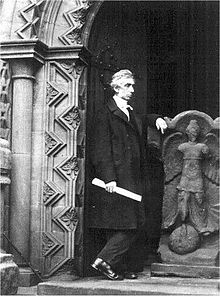|
John Collingwood Bruce
 The Reverend John Collingwood Bruce, FSA (1805 – 5 April 1892) was an English nonconformist minister and schoolmaster, known as a historian of Tyneside and author. He co-operated with John Stokoe in compiling the major song collection Northumbrian Minstrelsy published in 1882[1][2] Early lifeThe eldest son of John Bruce of Newcastle, he was educated at the Percy Street Academy, a well-known school in Newcastle kept by his father, and afterwards at Mill Hill School, Middlesex. He entered Glasgow University in 1821, graduated M.A. in 1826, and became hon. LL.D. in 1853. In early life, Bruce studied for the Presbyterian ministry, but never sought a call from any congregation. In 1831, he began to assist in the management of his father's school, of which he became sole proprietor in 1834, when his father died. He retired from the school, after a successful career, in 1863.[3] Historical interestsBruce's main interest was in the history of Britain, in particular North East England and more specifically Roman Britain and Hadrian's Wall. His books used a numbering system for the structures of the Wall, and by about 1930 it had become standard, using the milecastle located to the east. Examples are T33a or Turret 26B (Brunton). His interest in music was largely historical, and in editing the Northumbrian Minstrelsy he co-operated with John Stokoe. The article Music of Northumbria credits Stokoe with copying out, in 1850, some of the tunes from John Smith's tunebook of 1750, a book now long lost, and the pair creating this comprehensive collection of old Northern Songs. The work was on behalf of, and published by, the Ancient Melodies Committee of the Society of Antiquaries of Newcastle upon Tyne, of which Bruce was an active committee member. Bruce gave the Rhind Lectures in 1883, on the Roman occupation of Britain.[citation needed] FamilyHis father, also John, had been a schoolteacher for over 40 years, first in Alnwick, then in Newcastle. He was an author and had written books, including a work on Geography. He died at his home in Percy Street, Newcastle on 31 October 1834 aged 60 years.[4] Bruce married in 1833 Charlotte, daughter of T. Gainsford of Gerrard's Cross, Buckinghamshire, and had two sons and two daughters. The eldest son. Sir Gainsford Bruce, became one of the judges of the High Court of Justice.[3] John Collingwood Bruce died on 5 April 1892; his wife Charlotte died in 1893, and their daughter Frances died aged 18 months on 17 December 1839. They are buried in the family grave in Jesmond Old Cemetery.[5] A sculptured marble sarcophagus within St Nicholas' Cathedral shows the carved body of J. C. Bruce lying with his feet on a copy of his book Hadrian's Wall.[6] Selected worksMusic
The article Music of Northumbria, credits John Stokoe with copying out, in 1850, some of the tunes from John Smith's tunebook of 1750, a book now long lost, and, together with John Collingwood Bruce, creating this comprehensive collection of old Northern Songs. The work was on behalf of, and published by, the Ancient Melodies Committee of the Society of Antiquaries of Newcastle upon Tyne. Historical
Papers and magazine articles
References
Further reading
Attribution
External linksWikimedia Commons has media related to John Collingwood Bruce.
|